Juvenile JusticeOLD ENOUGH TO KNOW BETTER |
In
the un-humbled opinion of one, Poetic Justice...
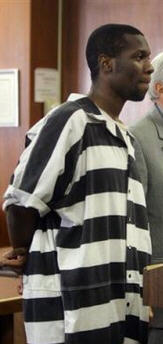 A Second Chance to Kill
A Second Chance to Kill
March 1,
2006
In 1999, when Lionel Tate was 12, he beat and stomped playmate Tiffany Eunick to death. The tiny victim was six years old. After a carefully crafted campaign to give the killer a second chance --Tate was granted bond and released from his life sentence for the brutal beating.
As punishment for Tiffany Eunick's dozens of injuries, fractured skull and dislodged liver -- Tate was given a slap on the wrist. In 2004 he was re-sentenced to the three years he'd already served and 11 years of probation.
Since that time -- and to this day -- Tate, his mother, and his lawyers have continued to maintain that he is not guilty of murdering Tiffany Eunick.
But on March 1, 2006, Lionel Tate pleaded guilty in a Broward County courtroom to a different crime -- the 2005 armed robbery of a pizza delivery man.
Prosecutor Chuck Morton said the 19-year-old only admitted his guilt because "he had an opportunity to avoid spending the rest of his life in jail." Tate's guilty plea could get him up to 30 years in prison but may spare him a life sentence for violating his probation.
All those people who dismissed Tiffany Eunick's murder as a childish mistake, and who cried and whined about Tate being too young to go to prison for life -- must now face the reality that they are directly responsible for Tate's crisis. Had he remained behind bars he would not have had the opportunity to commit more crimes against innocent people.
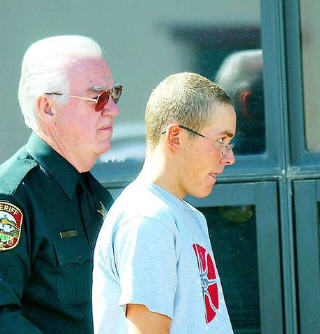
Cody Posey
It's not the Crime, it's
Cody Posey's Cover-Up
Cody Posey took an axe, and
Broke a window, to change the facts.
Once his phony note was done,
Into the river went his gun.
He dragged his victims out the door,
And buried them beneath manure,
Then called his friends, not 9-1-1,
For basketball, swimming and July 4th fun.
February 3,
2006
Poor Cody. At 14-years-old,
Cody Posey said he'd been kicked, slapped and punched by his dad nearly every day of his life. He said he was daily belitted by his parents and made to work long, hard hours without rest or water. He was even forced to save up money to buy his own boots.
Cody insisted he was the victim of violence and even sexual abuse -- and so THAT'S why he ambushed and killed his entire family.
Asked why he never went to authorities for help, poor Cody said he had -- and that one officer had given him a number to call . . . but that he must've lost it.
Cody could certainly remember the numbers 9-1-1. He was one of the top students at his school. Cody says he complained to friends, but never said a word to his teachers about any physical or emotional abuse.
Yet -- facing trial at 16-years old, the killer still maintains abuse made him bury the bodies of his father, stepmother and stepsister in manure and then go to a nearby house to party away the July 4th weekend.
"We didn't suspect nothing 'cause he was all happy," the neighbor said.
Cody's stepmother, Tryone Posey, was reading a book when he shot her twice in the head. Delbert Paul Posey, his father, was shot and killed in the kitchen. Cody's 14-year-old sister, Mary Lee (Marilea), was shot twice because, "she was still moving."
Defense lawyer Gary Mitchell asserts the teenager "snapped" after years of abuse.
During his lengthy presentation, Mitchell brought out the same bag of tricks he used in the Alien Love Queen trial. In that bizarre case, Mitchell's client claimed she killed in self-defense . . . since the victim was sent from outer space to destroy her. Cody Posey's stunning stories of abuse and sexual torture are turning out to be nearly as far-fetched.
Sheriffs, police officers, social workers, teachers, relatives and farmhands have directly contradicted every major point in Posey's testimony. Either Cody is lying . . . or they are. Particularly troubling for the defense was medical testimony about the defendant's sociopathic character traits and psychopathic tendencies -- chief among them: Cody is a liar.
Bryan Bashum, Tryone Posey's brother, never saw any evidence of daily torture.
"Cody told me ... he had been grounded for being on the Internet," Bashum said. "I jokingly asked him if he had been caught downloading nudie pictures." Cody told him he'd been caught visiting sites regarding criminal activities.
"He specifically mentioned the Menendez brothers, said if they had done it earlier they would have gotten away with it," said Bashum.
Cody swore to jurors -- on that fatal morning on newsman, Sam Donaldson's ranch, he had "more or less" lost his mind. The jury now knows -- immediately after murdering his family, Cody changed his bloody clothes and went to the store for a can of SPRITE.
If Cody "snapped" -- he snapped back awfully fast.
The day of the shootings one of Posey's teachers, Todd Proctor, saw Posey. Proctor said when he asked about the family, Posey responded "they were doing fine" and that the summer "was going great."
On the stand, Cody said, "I don't know what I was thinking. I couldn't tell you." That's a big, obvious, self-serving lie. A few days after the murder, he told police plenty.
He admitted killing Tryone Posey first, because she would have called 9-1-1. He told them exactly what he was thinking. He said he pumped two shots into Tryone's head -- the second "just to make sure I got her."
Those are Cody's words -- not the opinion of teenaged school buddies and empathetic relatives.
Cody also clearly told investigators what he was thinking when he killed his little sister. He confessed he shot her twice "so she wouldn't go and tell."
Cody Posey is a liar and a triple murderer. That's not my opinion -- that is a fact -- and that's why he is not to be trusted or believed.
Like the Menendez brothers, the King brothers, Chris Pittman, Holly Harvey, Sandy Ketchum, Victor Brancaccio and a host of other young "abused" defendants -- the charge against Cody Posey isn't merely murder. The charges include LIES, DECEPTION, and TAMPERING WITH EVIDENCE in order to conceal murder.
Mr. Mitchell didn't have to, but he chose to take on the burden of proving his client innocent of triple-murder. . . by reason of calamity.
That burden has not been met.
The part "self-defense," part "temporary insanity," part "street-justice" strategy was doomed from the start anyway. It failed to account for Posey's premeditated murder of his younger stepsister.
Both sides readily conceded that the Posey's were a family in crisis -- that's evident -- but Gary Mitchell insisted the family dynamics rose to the level of justifiable triple-homicide. The bottom line is -- he placed Cody on the stand to call his dead sister a "snitch," which made it impossible for Cody to tell the jury, "I'm sorry."
Truly tragic in Mitchell's mud-slinging and smear campaign, is that his legal defense is taking Cody Posey in the opposite direction from health and wellness as a person. Mitchell's determination to win in the courtroom may forever prevent the young man from truly coming to terms with the immensity of his unnatural acts.
Poor Cody.
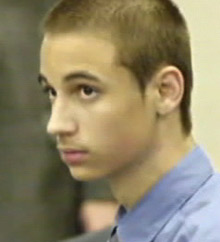
Christopher
Pittman
Burning Down the House
January 31,
2005
Christopher Pittman
appears to be no different than any other innocent young kid from Florida. To look at his angelic face,
one would never imagine that on November 28, 2001, he crept into his grandparent's bedroom and
killed them in cold blood.
At age 12, Chris stuck a shotgun into the mouth of his granddad, Joe
Frank as he slept, and pulled the trigger. Then turning to his grandmother,
Joy, he reloaded the gun and shot her to death. Afterward, he set
the Pittman's Chester, South Carolina home on fire, stole their car and fled
the scene.
Chris' crimes are amazingly similar to another
horrific murder and arson case that happened in Florida's panhandle: the November 30, 2001
murder of Terry King. In that case, the sweet angels behind the killing were Mr. King's
two sons, Derek, 14 and Alex, 12.
As with Chris Pittman, Alex and Derek went to great lengths to cover and disguise
the killing, but when setting fires and telling outrageous lies to police
finally failed and the terrible truth became known, they blamed it all on
child abuse. Claiming their murdered father and several other adults had
abused them -- the killer King's last appeal was for pity
-- pity because they were, after all, sweet, innocent-looking
kids.
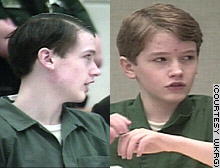
Alex and Derek King
Pittman's defense lawyers say the double murderer -- now 15 -- isn't to blame
for his actions because a few weeks prior to the senior citizen slayings,
Chris had been given a doctor's sample packet of the drug ZOLOFT.
A Florida juvenile blaming Pfizer Corporation's ZOLOFT for their crimes -- rings
another depressingly familiar bell.
In the late 1990's Victor Brancaccio was twice found guilty in the
beating death of senior citizen, Mollie Frazier. Although the troubled youth
had a clear history of extreme criminal behavior, his lawyers continued to insist
ZOLOFT made Victor attack the 81-year-old woman, kill her, hide her body
and cover her corpse in red spray-paint. Victor also had tried to burn the
pelvic area of Mollie Frazier's dead body.

Victor Brancaccio
Like Victor Brancaccio, Chris Pittman was very troubled.
Limping into 6th grade with a broken home and a broken heart -- no one doubts
Chris had been placed in harm's way by those who should have protected him.
Misbehaving at school, running away, choking student's on the school bus
-- these were all cries for help. It's criminal that no one came to his rescue.
No one, that is, except Joe and Joy Pittman, who agreed to try and help Chris
-- if he would agree to behave.
Chris killed the very people who loved him
-- the grandparents that took him in. He didn't kill because of ZOLOFT ABUSE,
he killed because he didn't get his way. Chris would later claim his granddad physically abused him.
As with most of these terrible teen cases, the very plausible explanation
of lashing out in a fit of "temporary adolescent insanity" is negated by the criminal's lies and
extensive cover-up of the crime.
While Chris may well have been experiencing side effects from
drugs before the murders, ZOLOFT can't account for why afterwards,
he stole his grandparent's car, money and guns. ZOLOFT doesn't explain why Chistopher Pittman
told outrageous lies to the police about being
held hostage by a big Black guy who had gunned down his grandparents.
Pittman wasn't too drugged up to try and
take full advantage of his innocent looks and blame the double murder on someone he figured
wouldn't look so cute to police -- a Black man.
Whether he's 12, 14 or 40, there's nothing remotely sweet or angelic about
a liar who killed truly innocent people -- who were only made vulnerable by their own kindness toward him.
"Everything just kept getting
worse, then I snapped and took everything out on my grandparents who I loved
so much. When I was laying in my bed that night, I couldn't sleep, my voice
kept echoing through my mind telling me to kill them until I got up, got
the gun, went upstairs and pulled the trigger."
-- letter from 12-year-old,
Christopher Pittman
Tate Pleas to the Second-Degree Murder
of Tiffany Eunick

Tiffany Eunick
December 10, 2003
Throughout Lionel Tate's trial his lawyers repeatedly claimed he was
just a confused teenager imitating pro-wrestling characters when he killed
Tiffany Eunick in July 1999. According to Defense attorney Jim Lewis, it
was not Tate, but rather a fantasy television show featuring a fictional
wrestler named "The Rock" who fractured 6-year-old Tiffany's skull, lacerated
her liver, broke her ribs and caused the internal hemorrhaging, cuts and
bruises.
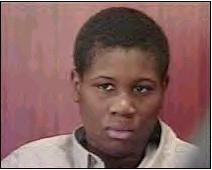
Despite the clever strategy, Mr. Lewis was denied in his request to have
"The Rock" and other wrestling entertainers testify during the trial. No
television stars were in the Miramar, Florida house with the 170-pound teenager
when he brutally beat the 48-pound girl, inflicting injuries which one State
expert said were comparable to falling from a three-story building.
The only adult in the home during the murder was Lionel's mother Kathleen
Grossett-Tate -- a Florida Highway Patrol trooper. She was baby-sitting little
Tiffany, but told police she was sleeping at the time. Ms. Grossett-Tate
got a rude awakening when her son was arrested and charged for the murder
of the small child left in her care.
Angry and indignant, Lionel Tate and his sleepy mom told police a story about
how the 13-year-old boy innocently picked up Tiffany Eunick and accidentally
hit her head against a table. When the autopsy made it painfully obvious
that those were lies, the story changed.
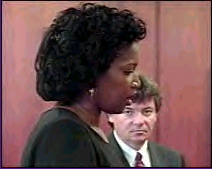
Tate would later explain to a court-appointed
psychiatrist that he accidentally hit the little girl against a wall and
a banister as he playfully tossed her onto a couch. Not even defense experts
bought into that version, but since Tiffany's mother was reluctant to proceed
with the case and prolong the agony, prosecutors offered the absurdly low
plea bargain of three years in juvenile detention for the savage killing.
The sweetheart deal was flatly refused, Lionel Tate's case was forced to
trial and the agony was prolonged for everybody. After viewing the horrific
photos of the dead victim and listening to defense attorney Lewis' lies,
a jury found Lionel Tate guilty. He was then sentenced to life in prison
without parole. It was a harsh outcome, but Tate certainly fared better than
his victim who was already dead by the time medics arrived to save her.
Three years after the verdict, appellate court judges have overturned
Tate's first-degree murder conviction and insist his life sentence should
be reversed because Tate's competency should have been evaluated before the
trial. The judges at the 4th District Court of Appeals didn't speak of Tate's
mother's year-long evaluations of the plea bargain, or the pre-trial competency
of Jim Lewis, who recklessly placed the teen in jeopardy and -- despite having
a team of doctors -- failed to have his client evaluated.
Defense lawyers never tire of proclaiming that they're duty-bound to vigorously
defend the accused at trial. Showboating attorney's love to cite the U.S.
Constitution as the reason they're forced to dance into court with creative,
Twinkie defense strategies. They seldom mention their primary duty as officers
of our severely over-burdened courts. I'm all in favor of a new trial for
Lionel Tate, as long as it's scheduled in conjunction with trials for his
mother, Kathleen Grossett-Tate and his crafty attorney Jim Lewis.
"He did not receive a fair trial the first time," Lionel Tate's mother snarled.
"For us to go back to trial again, I know he would not get a fair trial."
Kathleen Grossett-Tate said she had doubts about the new agreement because
it involves a second-degree murder plea instead of manslaughter. The new
plea offer, which essentially frees Tate, is the same deal Grossett-Tate
angrily rejected before the original trial.
The goal of our system is "justice for all" -- not simply for the accused.
Tragically, nothing in the appellate decision speaks to justice for the victim
or the possibility of parole for little Tiffany Eunick.
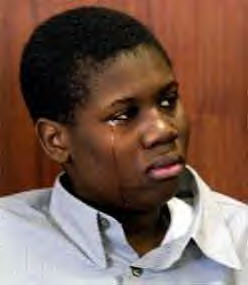
![]()
Prime Crime Age
We tend to think of criminals as older adults, but the "prime crime" age
is 18 - 20. The fact is, it isn't at all rare or unusual for teens and pre-teens
to commit horrible and violent criminal acts.
Cindy Collier was 15 and Shirley Wolf 14 when they started prowling
condominiums in California in 1983. They knocked on doors at random to gain
admittance. An elderly woman let them in and sat chatting with them as they
thought up a plan to steal her car. Shirley grabbed her by the neck while
Cindy found a butcher knife and tossed it to her. Shirley stabbed her victim
28 times, even as the old woman begged for her life. They fled the scene,
but were soon arrested. Both confessed that the murder was "a Kick" and that
they wanted to do another one. They thought it was fun.
In 1998, 14-year-old Joshua Phillips bludgeoned his 8-year-old neighbor,
and then hid her body beneath his waterbed.
February 1993 -- Robert Thompson and Jon Venables, both age ten, were
skipping school, shoplifting and looking for something to do. For a thrill,
they decided to see if they could get away with a kidnapping when they came
upon two-year-old James Bulger. The lifeless, battered body of young James
was later discovered near some railroad tracks. A train had cut it in half.
He still wore his jacket but his bottom half had been stripped of pants and
underwear. The boy was covered in blue paint, his lip had been ripped, an
eyelid torn, and there were numerous wounds to his scalp. When caught, Thompson
and Venables quickly supplied a series of confessions, each pinning the blame
on the other.
Willie Bosket had committed over two thousand crimes in New York by
the time he was fifteen, including stabbing several people. Killing
another young boy in a fight, he then embarked upon a series of subway crimes,
which ended up in the deaths of two men. He shot them, he later said, just
to see what it was like. It didn't affect him. He knew the juvenile laws
well enough to realize that he could continue to do what he was doing and
yet still get released when he was twenty-one. He had no reason to stop.
![]()
Records clearly indicated that Victor
Brancaccio was a dangerous teenager.
He had never had any formal criminal charges lodged against him by the state
of Florida, but nonetheless, the 16-year-old had exhibited bizarre and
threatening behavior. Brancaccio had a dark personality and a quick temper.
He as placed on Zoloft for his host of mental illnesses which included attention
deficit disorder and depression.
Brancaccio was a walking time bomb.
On June 11, 1993, after having an argument about dinner with his mother,
VICTOR Brancaccio stormed out of the house with his walkman radio. Along
the way, the teenager came upon Mollie Frazier, and had an argument with
her.
After VICTOR Brancaccio beat the senior citizen, he tried to destroy evidence
of his crime. He spray-painted her body red and attempted to set her on fire.
Brancaccio would later explain that Mollie Frazier had asked him to stop
singing to the offensive lyrics on his walkman.
Brancaccio was 16. Mollie Frazier was 81-years-old.
![]()
According to the Office of Juvenile Justice
and Delinquency Prevention, girls now account for 25% of juveniles arrested
for violent crimes,
In 1997, according to victims' reports, 70,000 serious violent crimes involved
one or more juvenile offenders between the ages of 12 and 17
Violent crimes committed by juveniles comprise about 1 in 4 of all violent
crimes nationwide.
![]()
Many youth feel disconnected — or are
disconnected — from family, school, and community. The opposite of
disconnection and alienation is not repair or control. It is connection and
involvement — passionate involvement. Youth know this. Many of them
voice or act on their profound loneliness, their innate need to belong. Said
one juvenile murderer, "I would rather be wanted for murder than not wanted
at all."
![]()
Juvenile violence and crime triple in the hour immediately after school
More than half of all 16-year-olds who ever committed assault, carried a
handgun, or belonged to a gang had done so for the first time by age 12.
Fewer than half of serious violent crimes committed by juveniles are reported
to law enforcement.
The direct and indirect costs to Americans of violent crimes and crimes involving
property are $425 billion each year
80% of violent crimes are committed by youths 14 through 24 years old.
Most violent crime victims are between 14 and 24 years old.
85% of the victims are male Hispanic and African Americans.
Most suspects know their victims.
Most of the violent crimes occur in the minority communities.
Most kids only go through the juvenile justice system once.
Within the next 10 years, the crime-prone age group will increase 40%.
Teenagers commit the largest portion of crime in America. While the national
rate of violent crime has leveled off and the nation's population of juveniles
has fallen, violent crimes committed by juveniles have risen dramatically.
More murders and robberies are committed by 18-year-old males than by any
other age group. More than one third of all murders are committed by offenders
under the age of 21.
By 2010, the number of 15-to-19-year-old males will be 11.5 million, an increase
of thirty percent from the 1995 low. The U.S. Department of Justice predicts
that juvenile arrests for violent crimes will more than double by the year
2010.
They also claim the number of youths arrested for murder will increase by
145 percent by the year 2010.
![]()
Average yearly, per-child spending in public schools?
About $8,000
Average cost of incarcerating a juvenile
for one year?
Between $35,000 to $64,000
![]()
Mike Males from "Color of Justice":
We looked at the available data from the Dept. of Justice and the Dept. of Corrections on youth arrested for violent crimes in California by race and transferred to adult court in Los Angeles county. Los Angeles is one of the few counties that had information on that subject. Then we looked at the figures statewide on youths who were sentenced to prison by adult court.
What we found was that Asian, African American and Latino youth were much more likely than white youth to be transferred to adult court even after they were arrested for violent crime. It wasn't simply the higher violent crime arrest rates of minority youths, but something else within the system was transferring them to adult court more often and then sentencing them to prison more often.
![]()
Percent of White defendants given probation or
non-incarceration sentence by state courts: 32%
Percent of Black defendants given probation or
non-incarceration sentence by state courts: 25%
Percent of White drug felons sentenced to prison
by state courts each year: 27%
Percent of Black drug felons sentenced to prison
by state courts each year: 43%
![]()
Black youth under age eighteen are incarcerated in adult facilities at rates
between twelve and twenty-five times greater than those of white youth.
Hispanic youth under age eighteen are incarcerated in adult facilities at
rates between seven and seventeen times greater than those of white youth.
Human Rights Watch reported: The figures reveal the continuing,
extraordinary magnitude of minority incarceration and the stark disparity
in their rates of incarceration compared to those of whites. Out of a total
population of 1,976,019 incarcerated in adult facilities, 1,239,946 or 63
percent are black or Latino, though these two groups constitute only 25 percent
of the national population.
In February of 2002, there were 18 White prisoners in Florida's prison system,
under the age of 18. In that same year, there were 119 Black prisoners inmates.
![]()
The average Black 12-year-old is more likely to go to prison than to college.
African American children are eight times more likely to go to prison
than whites.
The notion of harsh treatment and dreadfully long terms in violent prisons
for young people is far from a new debate. Black, Native American and Latino
youth have been fighting a war with the justice system for decades and decades.
To claim that this is new is just laughable.
The most recent battle was named the "War on Drugs", which was actually a
"War on "Thugs". "Lock 'em up and throw away the key!" was the cry.
"Three strikes and you're out!" "Zero Tolerance!"
![]()
African Americans make up about 12% of the population.
Percent of White felony drug defendants in state courts: 37%
Percent of Black felony drug defendants in state courts: 37%
![]()
KIDS WILL BE KIDS
A 10-year-old Milwaukee boy accused
of participating in the mob beating of a 36-year-old man will not stand trial
as an adult. He was charged with second-degree reckless homicide in Milwaukee
County Children's Court.
The boy, assisted by a gang of 13 and 14-year-olds, attacked Charlie
Young, 36, near his home until he was left brain dead. He was charged
today with second-degree reckless homicide, but will not stand trial as an
adult.
Predictably, the killer's father stood outside the courthouse screaming that
his son is simply a confused and scared little angel saying, "Kids are going
to be kids. They're being rolled up and they don't know what's happening."
Also at the court center, the 10-year-old boy's sister said it would have
been an injustice to make him the youngest person ever tried as an adult
in the country. "If a grown man can't deal with prison, how can a 10-year-old?"
the sister asked shortly before the hearing began. "He's not a monster. He's
a 10-year-old little boy."
The sister of the 10-year-old claimed "Those children didn't mean for this
to happen. I know that in my heart."
A sister of two of the gang suspects, said the victim, Mr. Young himself
had instigated the fight. Several of the juveniles arrested in the case told
police Young had threatened the group in response to being hit with an egg
thrown by the 10-year-old. She also of course, insisted the parents were
not to blame for the murder. "People don't give credit to the mother who's
a hard-working parent and a single parent." The woman said. She said her
mother has raised seven children by herself and has suffered abuse.
![]()
==================================
Every 10 hours, someone in Florida is murdered.
==================================
Florida Department of Law Enforcement
By whatever basis juvenile crime in Florida is measured it is apparent that
the state, like the nation, faces a serious problem. The "typical" juvenile
offender is male, between the ages of 15 and 17.
![]()
Juvenile Fire Starters
Everyone's knows what the crime of arson is, but most people don't realize
just how frequently it happens, who the arsonists are, why they purposely
start fires, or the extent of the damage they cause.
According to the U.S. Fire Administration: Juveniles start up to 40% of all
"set" fires in America, and this figure is considerably higher in many
communities.
Before this day ends, approximately 700 fires will purposely be set by people
under the age of 18, at an estimated cost of over a billion dollars a year.
Arson is one of the leading crimes committed by juveniles. Over half of all
arrests for arson are juveniles.
50% of juvenile set fires occur in people's homes and other structures
90% of those who die in fires started by children, are children. Every year
300 juveniles will die and 3,000 will be seriously injured by a youth arsonist.
There are 4 types of juvenile arsonists. Most fires are set by "delinquent
firesetters", youth wanting to create a disturbance, to deliberately
destroy something, to "get even" with somebody or peer pressure.
The other youth arson types identified by the USFA are: adolescents expressing
trauma or stress in their life, called "crisis firesetters", emotionally
disturbed youth called " pathological firesetters", and the unthinking,
inquisitive "curiosity firesetters".
Without placing the child into a proven juvenile firesetters intervention
program, the recidivism (repeat) rate is in excess of 80%.
![]()
In New York, a youth was sent to a limited secure facility for burning a
homeless man to death. The youth, along with others, beat the man in a park
and poured an accelerant all over is clothing. The man was lit on fire and
died an agonizing death.
For this crime of unspeakable violence, the youth received the maximum term
of incarceration--a period of up to 18 months. It is likely that the offender
will serve a mere ten months for this crime.
![]()
In September 1993 a tourist was murdered at a Florida rest stop by
four teenagers. It was the ninth tourist slaying in Florida since the previous
fall. One teenager had 30 prior arrests, another, 26.
The public was outraged, demanding to know why -- why had these criminals
repeatedly been given a "slap on the wrist" and then released to terrorize
the public again? The answer came back loud and clear from police and prosecutors
all over the state -- sentencing in the juvenile justice system is based
on rehabilitation guidelines, not punishment.
After the next legislative session, prosecutors had "direct file" -- the
power to bypass the juvenile system and charge juvenile defendants in adult
court for serious crimes.
Juvenile crime in Florida, over all, has steadily fallen since a peak in 1995.
Despite the current media furor about Florida's "direct file" option, the
numbers clearly show that the laws make sense and are applied fairly.
To be sure -- law-breakers sent to juvenile programs are more likely to stay
out of trouble than those routed to prison and the vast majority of youth
offenders are, in fact, sent to the juvenile system.
It is only the worst of the worst offenders that go to trial as adults.
Nine of 10 juveniles in adult prisons had been previously arrested for violent
crimes, and each averaged 16 total charges as juveniles, the Florida Department
of Corrections said in a 1999 study.
No one in Florida or any where else delights in the idea of trying or sentencing
young people in the adult system. Adult courts and prisons were designed
to punish. They are not rehabilitation centers.
Florida has some of the toughest laws in the nation, still, there are very
few cases where prosecutors may file in adult court: defendants charged with
their second violent crime against a person or three prior felony adjudications
-- any "carjacking" that results in serious injury -- crimes of extreme violence
-- and murder.
Even so, offenders are given wide latitude. Over forty percent of those juveniles
tried in adult court, get probation with no jail-time. They are given a second
chance -- unfortunately, juveniles on probation often get in trouble again.
One in three violate their probation rules and go to prison anyway.
Homicides make up just two of every 100 adult court convictions of juveniles.
That number is very small when you consider that currently, only one in 13
Florida prison inmates are doing time for a crime committed as a youth.
Changing behavior in violent offenders of any age is not a simple matter
and depends on a commitment from the offender. Most young people deserve
a juvenile process that will give them another chance through rehabilitation
-- but those who refuse to make the commitment need to be punished and put
safely behind bars.
![]()
Children as young as preschoolers can show violent behavior. Parents and
other adults who witness the behavior may be concerned, however, they often
hope that the young child will "grow out of it." Violent behavior in a child
at any age always needs to be taken seriously. It should not be dismissed
as "just a phase they're going through!"
Violent behavior in children and adolescents can include a wide range
of behaviors: explosive temper, tantrums, physical aggression, fighting,
threats or attempts to hurt others (including homicidal thoughts), use of
weapons, cruelty toward animals, fire setting, intentional destruction of
property and vandalism.
![]()
Numerous research studies have concluded that a complex interaction or
combination of factors leads to an increased risk of violent behavior in
children and adolescents. These factors include:
| Vance Holmes.com / court |
| And Poetic Justice For All |